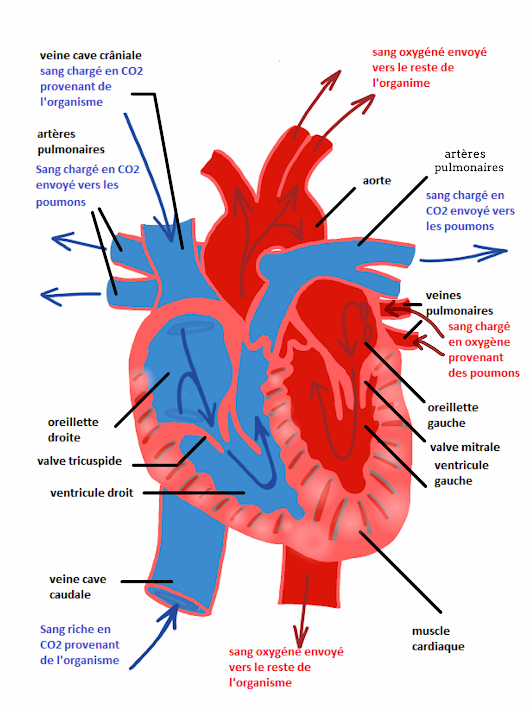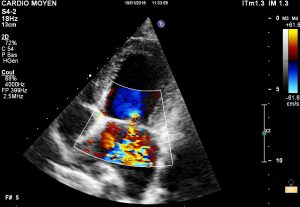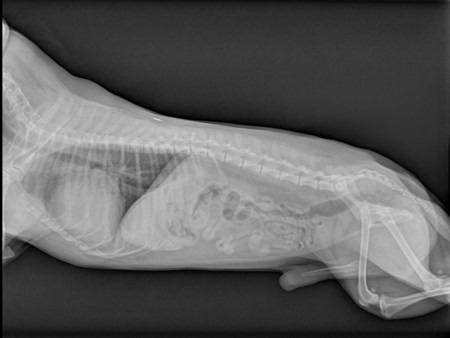
Heart disease in dogs
A little physiology ...
The heart is a muscle whose function is to send blood to the organs to distribute their oxygen and nutrients. The heart rate is between 60 and 180 beats per minute in the adult dog depending on its size. It is up 220 beats per minute in puppies.
The heart is divided into two parts : the right heart and the left heart. Each of these halves is itself divided into two cavities, an atrium and a ventricle.
The left heart receives blood laden with oxygen that just passed in the lungs and sends throughout the body.
The right heart, his, receives blood loaded carbon that comes from the body and sends dioxide in the lungs for it charges oxygen.
The oxygenated blood then returns to the left heart, And so on.
The work of the heart is essential for the proper functioning of the body and a defect in this work may have more or less serious consequences.

Diagram showing the flow of blood through the heart
Symptoms of heart failure
There is talk of heart failure when the heart no longer fulfills its role properly and that this anomaly affects the dog's health.
Depending on the origin of heart failure, the observed symptoms can be :
- Shortness of breath and fatigue on exertion.
- weight loss
- Irregular breathing, difficult, especially when it is hot.
- Cough.
- Syncope.
If your dog shows any of these abnormalities, Take immediately contact your veterinarian to describe her troubles you have noticed in your pet.

The observation of certain symptoms may sign the presence of severe heart failure. They should alert you and make you go urgently to your veterinarian
It could be :
- The occurrence of syncope, discomforts,
- In the presence of an abdominal effusion called ascites : accumulation of fluid is present in the abdomen of the animal and its belly is swollen than usual
- In the highlight of respiratory distress : the dog seems to really present great difficulties to oxygenate, his wheezing, his mouth open, his neck stretched, respiratory movements of the thorax and abdomen are not simultaneous (talking mismatch), mucous membranes (gums, lips, tongue…) take a blue coloration (symptom called cyanosis) . These signs indicate the presence of & rsquo; an edema Acute Lung (OAP), final stage of the & rsquo; evolution & rsquo; heart failure and absolute urgency !!!
The various heart diseases in dogs
Various heart conditions exist and will differentiate the part of the heart that is concerned. It is possible to distinguish particularly :
The degeneration of the heart valves (dégénrative valvular disease or MVD)
les valvules sont des membranes here concrétiser the oreillette and the ventricule and assurent the deslizante König cavités lors de la contraction of muscle cardiaque. When the valves are malfunctioning, some of the blood can rise from the ventricle to the atrium which goes against the normal flow direction and makes the heart work. Valvular degeneration is due to age. It thus appears mainly in aging dogs.
The valve of the left heart's mitral valve. When this valve is reached, we speak of mitral regurgitation. This is the most common heart disease in dogs, representative 75 to 80% cases. It is particularly common in small dogs.
The valve of the right heart's tricuspid valve. When this valve is reached, we speak of tricuspid regurgitation.
Les cardiomyopathies
Cardiomyopathy is a disease of the myocardium (or heart muscle) which can have various origins. Cardiomyopathy that affects preferentially the dog is dilated cardiomyopathy (CMD). In this condition, the heart muscle is usually much thinner than normal, no longer contracts properly and can then no longer play its role effectively. The cavities are dilated and the heart volume is usually significantly increased. Also known as dilated cardiomyopathy. This disease is more common in large dogs, with racial predispositions, for example, at the Doberman, Boxer, Great Dane or the Newfoundland.

Birth defects
Although it is rare, Puppies can suffer birth defects or congenital heart disease.
These defects can affect :
the valves : defects can then affect the mitral valve, the tricuspid valvule, but also the valves of the two main arteries from the heart, the pulmonary artery and aorta. As in the case of valvular degeneration, sealing defects exist then and the blood circulation is poor.
The presence of an extra shunt or intracardiac : a blood passage is possible between two parts of the heart that should not normally communicate with each other. This is the case, including, for congenital illness called patent ductus arteriosus : A shunt between the pulmonary artery and the aorta arises from the abnormal persistence of a channel that normally closes at birth naturally puppy. These anomalies generate disorders of blood flow.
cardiac rhythm disorders
The frequency or regularity of the heartbeat are then modified. The mechanisms and causes of these disorders are varied.
Diagnosis
To establish a diagnosis, your veterinarian will rely primarily on the symptoms you describe it to them and the clinical examination he will realize. Auscultation with a stethoscope can sometimes be enough to guide the diagnosis, particularly when a "breath" is audible. A heart murmur is a sign that the blood flow in the heart is not done correctly.
Additional tests are very often needed to clarify the diagnosis : the examination of choice is often echocardiography (which allows to know exactly what heart disease is reached & rsquo; animal, d & rsquo; estimate the severity of this disease and d & rsquo; better adjust the necessary treatment), but can also be very useful and even indispensable d & rsquo; other tests such as chest x-rays, electrocardiogram…

Degenerative mitral valve disease in a Beauceron

Increased heart size observed over a chihuahua radiography
treatments
The treatments set up in heart disease are of several types
medicated
Depending on the detected pathology, drug treatments are used to help the heart function as well as possible in the least fatiguing. These treatments are very helpful, even if they do not provide a cure for heart disease. It comes, in general, a daily treatment to give life. This treatment may be supplemented by diuretic drugs when signs of pulmonary edema have been detected.
A dog can remain under treatment for several years without that quality of life is affected.

Hygienic
As with humans, the lifestyle is integral to the treatment of heart disease.
On the one hand, physical exercise is not prohibited but must be reasonable. Tone down your dog's efforts because it will not do for itself : walk on a leash, avoid violent efforts, and especially during the hottest hours of the day.
On the other hand, Food also plays an important role because it can help relieve the heart work. Specific foods exist, talk with your veterinarian.
Surgical
Advances in veterinary medicine have now made possible some surgeries. The repair of birth defects, or degenerative valvular, You may be offered with results that can be very interesting.
Discuss these options and prognosis with your veterinarian.
Author : Dr Hélène Blondel. Illustrator : Dr. Caroline Allard – Vetup®
